Page 252 of 395
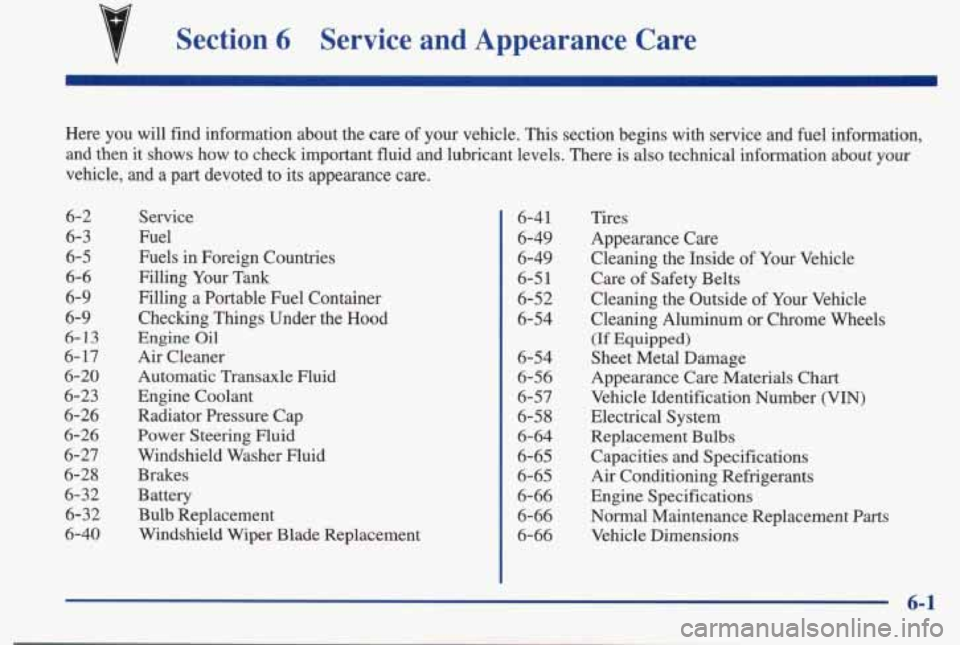
Section 6 Service and Appearance Care
Here you will find information about the care of your vehicle.\
This section begins with service and fuel information,
and then it
shows how to check important fluid and lubricant levels. There is also technical information about your
vehicle, and a part devoted to its appearance care.
6-2
6-3
6-5
6-6
6-9
6-9
6-13
6- 17
6-20
6-23
6-26
6-26
6-27
6-28
6-32
6-32
6-40
Service
Fuel
Fuels in Foreign Countries
Filling Your
Tank
Filling a Portable Fuel Container
Checking Things Under the Hood
Engine
Oil
Air Cleaner
Automatic Transaxle Fluid
Engine Coolant
Radiator Pressure Cap
Power Steering Fluid
Windshield Washer Fluid Brakes
Battery
Bulb Replacement Windshield Wiper Blade Replacement
6-4 1
6-49
6-49
6-5
1
6-52
6-54
6-54
6-56
6-57
6-58
6-64
6-65
6-65 6-66
6-66
6-66
Tires
Appearance Care
Cleaning the Inside of Your Vehicle
Care
of Safety Belts
Cleaning the Outside of Your Vehicle
Cleaning Aluminum or Chrome Wheels
(If Equipped)
Sheet Metal Damage
Appearance Care Materials Chart
Vehicle Identification Number
(VIN)
Electrical System
Replacement Bulbs
Capacities and Specifications
Air Conditioning Refrigerants
Engine Specifications
Normal Maintenance Replacement
Parts
Vehicle Dimensions
6-1
Page 254 of 395
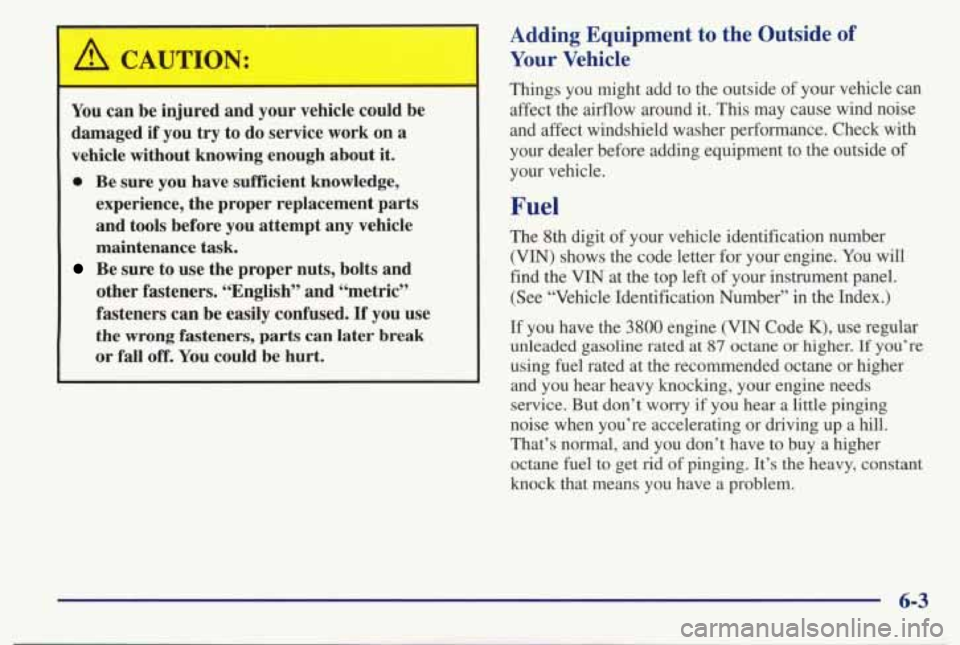
/1 CAUTION:
You can be injured and your vehicle could be
damaged
if you try to do service work on a
vehicle without knowing enough about it.
0 Be sure you have sufficient knowledge,
experience, the proper replacement parts
and tools before you attempt any vehicle
maintenance task.
Be sure to use the proper nuts, bolts and
other fasteners. “English” and “metric”
fasteners
can be easily confused. If you use
the wrong fasteners, parts can later break
or fall
off. You could be hurt.
Adding Equipment to the Outside of
Your Vehicle
Things you might add to the outside of your vehicle can
affect the airflow around it. This may cause wind noise
and affect windshield washer performance. Check with
your dealer before adding equipment to the outside
of
your vehicle.
Fuel
The 8th digit of your vehicle identification number
(VIN) shows the code letter for your engine. You will
find the VIN at the top left
of your instrument panel.
(See .“Vehicle Identification Number”
in the Index.)
If you have the 3800 engine (VIN Code K), use regular
unleaded gasoline rated at 87 octane or higher. If you’re
using fuel rated at the recommended octane or higher
and you hear heavy knocking, your engine needs
service. But don’t
worry if you hear a little pinging
noise when you’re accelerating or driving up a
hill.
That’s normal, and you don’t have to buy a higher octane fuel to get
rid of pinging. It’s the heavy, constant
knock that means you have a problem.
6-3
Page 255 of 395
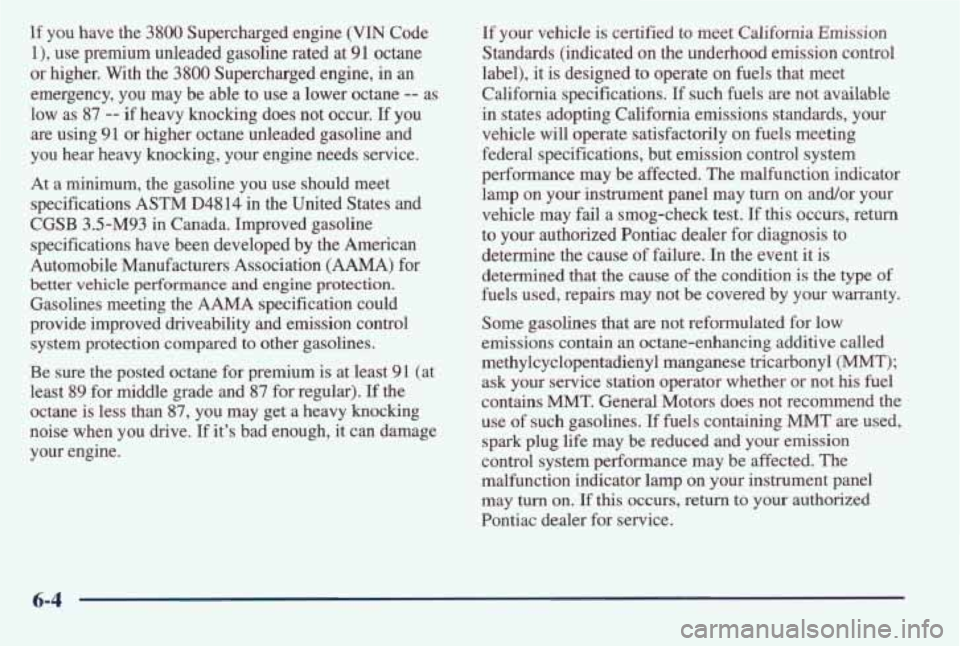
If you have the 3800 Supercharged engine (VIN Code
l), use premium unleaded gasoline rated at 91 octane
or higher. With the
3800 Supercharged engine, in an
emergency, you may be able to use a lower octane -- as
low as
87 -- if heavy knocking does not occur. If you
are using
91 or higher octane unleaded gasoline and
you hear heavy knocking, your engine needs service.
At a minimum, the gasoline you use should meet specifications
ASTM D4814 in the United States and
CGSB 3.5-M93 in Canada. Improved gasoline
specifications have been developed by the American
Automobile Manufacturers Association
(AAMA) for
better vehicle performance and engine protection.
Gasolines meeting the AAMA specification could
provide improved driveability and emission control
system protection compared to other gasolines.
Be sure the posted octane for premium is at least
91 (at
least
89 for middle grade and 87 for regular). If the
octane is less than
87, you may get a heavy knocking
noise when you drive. If it’s bad enough, it can damage
your engine.
If your vehicle is certified to meet California Emission
Standards (indicated
on the underhood emission control
label), it is designed to operate on fwels that meet
California specifications. If such fuels are not available
in states adopting California emissions standards, your vehicle will operate satisfactorily
on fuels meeting
federal specifications, but emission control system
performance may be affected. The malfunction indicator lamp on your instrument panel may
turn on and/or your
vehicle may fail a smog-check test. If this occurs, return
to
your authorized Pontiac dealer for diagnosis to
determine the cause of failure.
In the event it is
determined that the cause of the condition
is the type of
fuels used, repairs
may not be covered by your warranty.
Some gasolines that are not reformulated
for low
emissions contain
an octane-enhancing additive called
methylcyclopentadienyl manganese tricarbonyl
(MMT);
ask your service station operator whether or not his fuel
contains
MMT. General Motors does not recommend the
use of such gasolines. If fuels containing MMT are used,
spark plug life may be reduced and your emission
control system performance may be affected. The
malfunction indicator lamp
on your instrument panel
may
turn on. If this occurs, return to your authorized
Pontiac dealer for service.
6-4
Page 256 of 395
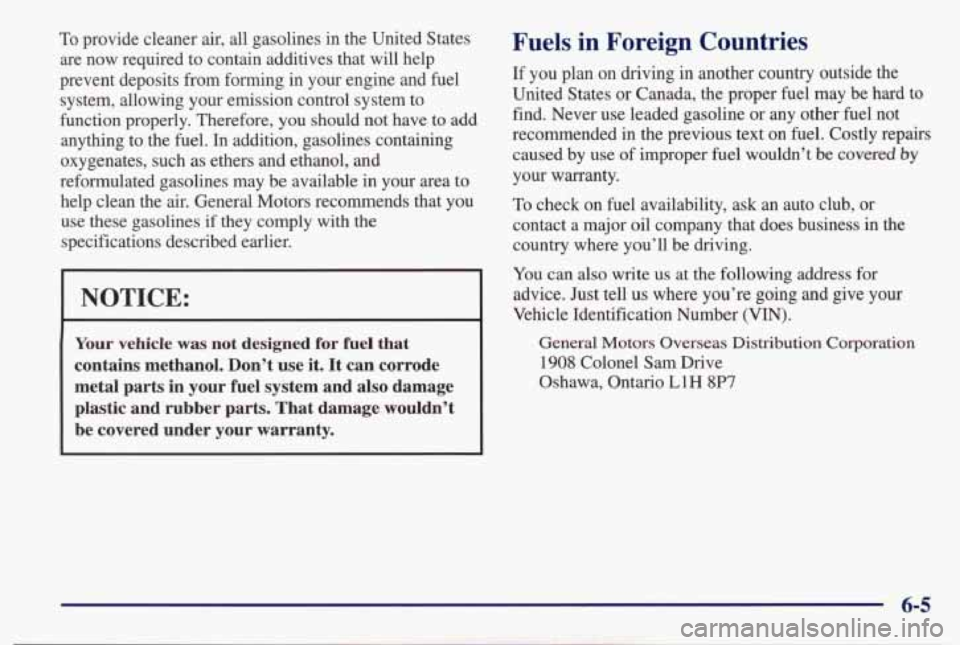
To provide cleaner air, all gasolines in the United States
are now required to contain additives that will help
prevent deposits from forming in your engine
and fuel
system, allowing your emission control system to
function properly. Therefore, you should not have to add
anything to the
fuel. In addition, gasolines containing
oxygenates, such
as ethers and ethanol, and
reformulated gasolines may be available in your area to
help clean the
air. General Motors recommends that you
use these gasolines
if they comply with the
specifications described earlier.
NOTICE:
Your vehicle was not designed for he1 that
contains methanol. Don’t use it. It can corrode
metal parts in your fuel system and
also damage
plastic and rubber parts. That damage wouldn’t
be covered under your warranty.
Fuels in Foreign Countries
If you plan on driving in another country outside the
United States or Canada, the proper fuel may be hard to
find. Never use leaded gasoline or any other
fuel not
recommended in the previous text on fuel. Costly repairs caused by use of improper fuel wouldn’t
be covered by
your warranty.
To check on fuel availability, ask an auto club, or
contact a major oil company that does business in the
country where you’ll be driving.
You
can also write us at the following address for
advice. Just tell
us where you’re going and give your
Vehicle Identification Number
(VIN).
General Motors Overseas Distribution Corporation
1908 Colonel Sam Drive
Oshawa, Ontario
L1H 8W
Page 260 of 395
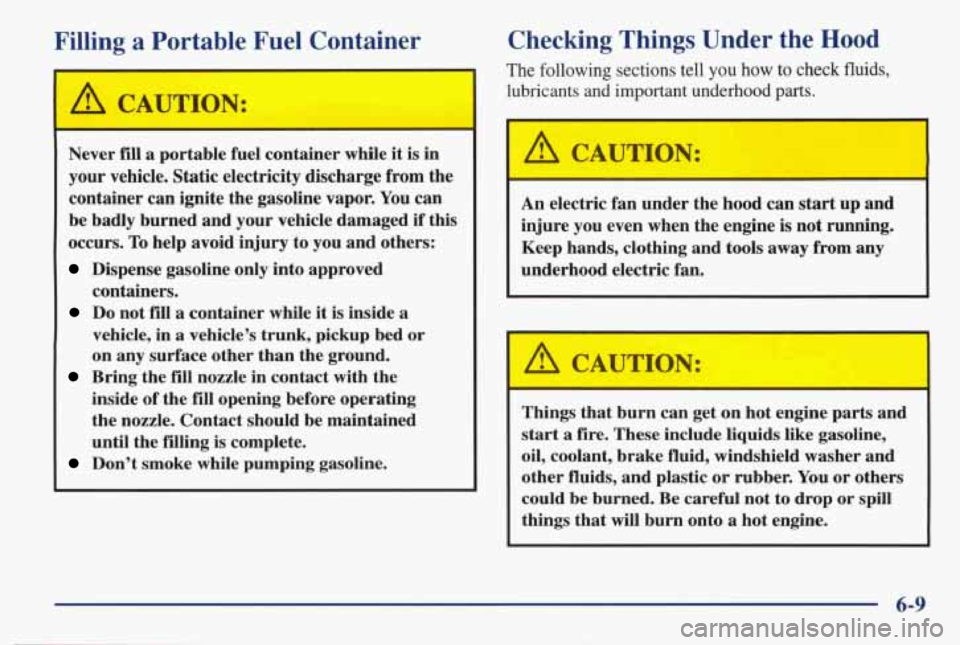
Filling a Portable Fuel Container
I
1 A CAUTION: I
Never fill a portable fuel container while it is in
your vehicle. Static electricity discharge from the
container can ignite the gasoline vapor. You can
be badly burned and your vehicle damaged
if this
occurs. To help avoid injury to you and others:
Dispense gasoline only into approved
containers.
Do not fill a container while it is inside a
vehicle, in a vehicle’s trunk, pickup bed or
on any surface other than the ground.
inside of the fill opening before operating
the nozzle. Contact should be maintained
until the ring
is complete.
Bring the fill nozzle in contact with the
Don’t smoke while pumping gasoline.
Checking Things Under the Hood
The following sections tell you how to check fluids,
lubricants and important underhood parts.
A CAUTION:
I
An electric fan under the hood can start up and
injure you even when the engine
is not running.
Keep hands, clothing and tools away from any
underhood electric fan.
A CAUTION:
Things that burn can get on hot engine parts and
start a fire. These include liquids like gasoline,
oil, coolant, brake fluid, windshield washer and
other fluids, and plastic or rubber. You or others
could be burned. Be careful not to drop or spill
things that
will burn onto a hot engine.
I
6-9
Page 262 of 395
3800 Series I1 Engine (L36 - Code K)
When you open the hood, you'll see:
A. Engine Coolant
Recovery Tank
B. Battery
C. Radiator Pressure Cap
D. Engine Oil Dipstick
E. Engine Oil Fill Cap
E Automatic Transaxle
Fluid Dipstick
G. Brake Master Cylinder
H. Air Cleaner
I. Windshield Washer
Fluid Reservoir
6-11
Page 263 of 395
3800 Supercharged Engine (L67 - Code 1) (If Equipped)
When you open the hood, you’ll see:
A. Engine Coolant
Recovery Tank
B. Battery
C. Radiator Pressure Cap D. Engine Oil Dipstick G. Brake Master Cylinder
E. Engine Oil Fill Cap
H. Air Cleaner
E Automatic Transaxle I. Windshield Washer
Fluid Dipstick Fluid Reservoir
Page 264 of 395
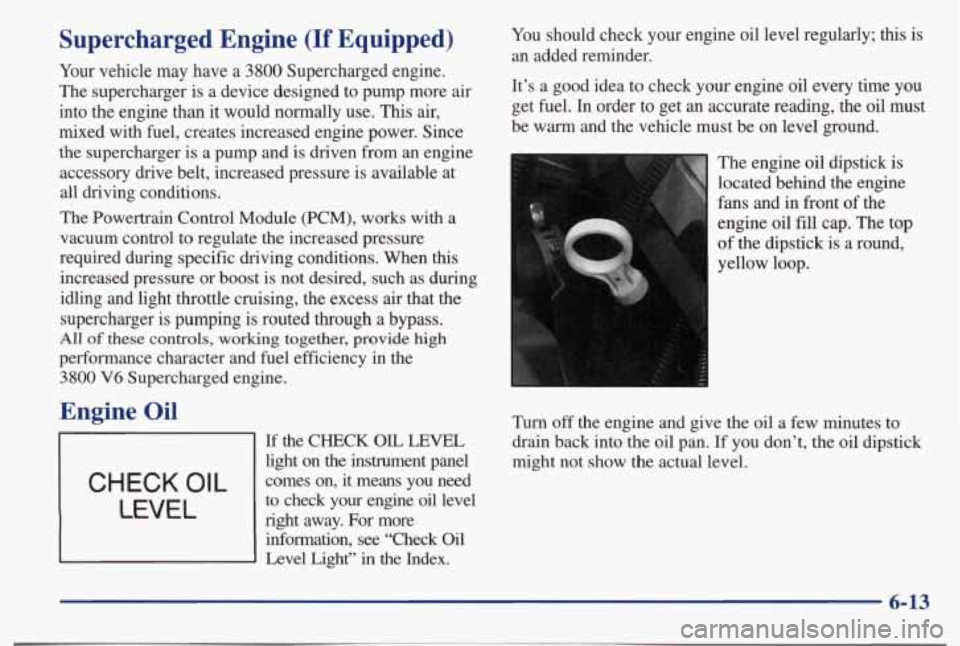
Supercharged Engine (If Equipped)
Your vehicle may have a 3800 Supercharged engine.
The supercharger is a device designed to pump more air
into the engine than it would normally use.
This air,
mixed with fuel, creates increased engine power. Since
the supercharger is a pump and is driven from an engine
accessory drive belt, increased pressure is available at
all driving conditions.
The Powertrain Control Module (PCM), works with a vacuum control to regulate the increased pressure
required during specific driving conditions. When this
increased pressure or boost is not desired, such
as during
idling and light throttle cruising, the excess
air that the
supercharger is pumping is routed through
a bypass.
All of these controls, working together, provide high
performance character and fuel efficiency in the
3800 V6 Supercharged engine.
Engine Oil
CHECK OIL
LEVEL
If the CHECK OIL LEVEL
light on the instrument panel
comes
on, it means you need
to check your engine oil level
right away.
For more
information,
see “Check Oil
Level Light” in the Index. You
should check your engine oil level regularly;
this is
an added reminder.
It’s
a good idea to check your engine oil every time you
get fuel.
In order to get an accurate reading, the oil must
be warm and the vehicle must be on level ground.
Turn
off the engine and give the oil a few minutes to
drain back into the oil pan. If you don’t, the oil dipstic\
k
might not show
the actual level.
6-13